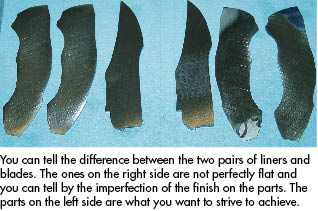
Depending on the tooth per inch, you might want to run a little bit faster when you are cutting thin liner materials. If you do not run the blade faster, you are chancing stripping the teeth off the blade.
When cutting, I use a push-stick to protect my fingers and allow leverage in tight areas. I also wear gloves, mainly to lessen the vibration to my hands.
All titanium liners will be placed on my lapping machine. This machine laps the surface of the titanium so it is flat. The reason why you want your liners flat is that you will get a much smoother action and prevent warping of the liners, and thus the stressing of the folder when it is put together.
In the lapping machine, I separate the liners with a Micarta square so they do not interfere with each other. A foam pad is placed on top of the liners and on top of the foam pad is a 20-pound weight. The pad helps distribute the weight evenly on the liners. As the machine rotates, three rings also rotate giving an even and random motion against an abrasive disk.
While the liners are lapping, I grind the blade to the scribed line with a 60-grit belt. Remember, again, to use proper ear, eye and lung protection.
After the blade has been profiled to the scribed line, I flatten one side on a disk.
I use the pattern to spot all the holes I will need to drill. After I am done spotting the blade, I remove the pattern and start drilling the holes to the correct sizes. I screw an aluminum rod into the drill table to protect me from any blade that could be pulled out of my hand by the drill bit.
Before heat-treating, I ream the tang area of the blade to a .2850-inch diameter, and my pivot pin is .250-inch in diameter. The reason why I ream undersize is because this is a damascus blade, and when I etch it, the acid will enlarge the pivot hole.
Once the blade has been profiled, drilled and reamed, it is ready for heat-treating. I wrap the blade in steel foil, and with a carbide scribe, I poke a small breather hole in the corner of the foil bag. If you do not do this, at high temperatures, all the oxygen will be burned out of the bag and it will create a vacuum. In a vacuum situation, the chances of warping your blade or of the bag welding itself to your blade are extremely high.
I take my handle pattern and clamp it onto the .050-inch-thick liner that I’ve chosen to be the lock side. Now I can spot the holes and drill them to the appropriate sizes. I take my .100-inch-thick bolsters to the disk grinder to de-burr and flatten them.
 NEXT STEP: Download Your Free KNIFE GUIDE Issue of BLADE Magazine
NEXT STEP: Download Your Free KNIFE GUIDE Issue of BLADE Magazine
BLADE’s annual Knife Guide Issue features the newest knives and sharpeners, plus knife and axe reviews, knife sheaths, kit knives and a Knife Industry Directory.Get your FREE digital PDF instant download of the annual Knife Guide. No, really! We will email it to you right now when you subscribe to the BLADE email newsletter.







